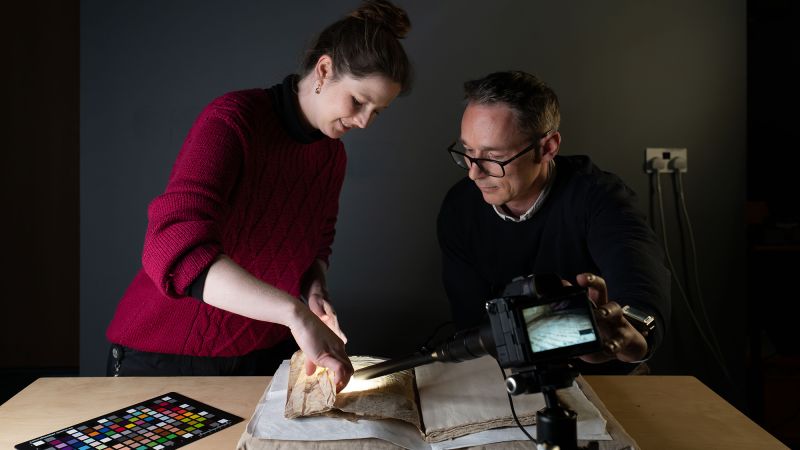In an extraordinary discovery at the Cambridge University Library in England, researchers have uncovered portions of a rare medieval manuscript hidden within the binding of another book. This remarkable find consists of two pages that narrate tales of the iconic figures Merlin and King Arthur, adding a significant piece to the tapestry of Arthurian legend.
The pages hail from a 13th-century edition of the “Suite Vulgate du Merlin,” a manuscript penned in Old French. This document serves as a sequel to the famed tales of King Arthur and features one of only a handful of surviving copies, with just over thirty extant versions known to exist today. Dr. Irène Fabry-Tehranchi, a French specialist and academic liaison at Cambridge University, noted the manuscript’s historical value and its popularity among the medieval aristocracy. She elaborated on how these stories were often performed by traveling poets known as trovères, emphasizing the manuscript’s role in a literary tradition influential in royal courts.
Due to the fragile nature of the pages, researchers opted against physically removing them from their stitched confinement. Instead, they used cutting-edge imaging techniques, including computed tomography (CT) scans, to create a digital 3D model of the manuscript. This innovative approach allowed them to virtually “unfurl” the pages and read the text without risking damage.
Dr. Fabry-Tehranchi characterized the discovery as a “once-in-a-lifetime experience,” underscoring its exceptional nature. The scans not only revealed the text but also provided insights into ancient book-binding methods and details that could illuminate the manuscript’s origins. The process of studying this artifact extended beyond mere textual analysis; it encompassed unraveling the material heritage that it represents.
The manuscript’s journey to rediscovery began in 2019 when Sian Collins, a former archivist at Cambridge, stumbled upon it while reclassifying records from the Vanneck family estate at Huntingfield Manor in Suffolk, England. Initially cataloged as a 14th-century story of Sir Gawain, it became apparent to Collins that the text was actually written in Old French—indicative of a high status associated with the language in medieval England, particularly post-Norman Conquest in 1066.
As Collins and her colleagues examined the manuscript, they deciphered passages that depicted the valiant exploits of Gawain and his allies against the Saxon Kings. Additionally, one fragment from Arthur’s court illustrated Merlin’s entrance as a charismatic musician. This scene highlighted the cultural and narrative elements that have sustained the Arthurian mythos for centuries.
Moreover, the finds revealed how the manuscript had been altered over the years. Once folded, torn, and sewn, it posed challenges in interpretation, but experts from Cambridge overcame these hurdles through scrupulous analysis. They concluded that the manuscript, adorned with intricate initials in red and blue, was crafted in northern France between 1275 and 1315, likely before being transported to England.
The nature of manuscripts during the medieval age was predominantly unique; each copy varied due to the fluidity of written language at the time. The researchers posited that the version they discovered might represent a condensed retelling of the “Suite Vulgate du Merlin.” The differences in names, such as “Dorilas” as opposed to “Dodalis,” showcase the individuality inherent in each handmade text.
The transformation of manuscripts into materials for other uses has a rich history, particularly as printing technology matured by the end of the 16th century. Old texts like this one were often discarded in favor of their durable parchment, which was repurposed for more practical needs. Moreover, the evolving literacy rates rendered Old French texts less accessible, leading to the rise of translated and modernized adaptations such as Sir Thomas Malory’s “Morte d’Arthur.”
This raises compelling questions about the adaptability of the Arthurian legend. Dr. Laura Campbell, an expert in the subject, remarked on the importance of these tales, noting that their appeal lies in their timelessness, allowing for ongoing reinterpretation to resonate with different audiences. The researchers employed an advanced array of photographic techniques, capturing the manuscript across various light spectra to enhance its readability and reveal hidden annotations, thereby preserving as much of the original content as possible.
In conclusion, the collaborative efforts of the research team at Cambridge University have not only enriched the understanding of this medieval manuscript but also highlighted the methodologies that can be employed for future studies of similar historical artifacts. Their work sets a precedent for non-invasive techniques that balance conservation with scholarly inquiry, aiming to encapsulate the past while providing access to its narratives for future generations.












